Contract Theory-Based Incentive Mechanism for Full Duplex Cooperative NOMA with SWIPT Communication Networks
Abstract
:1. Introduction
1.1. Related Work
1.2. Our Contribution
- In FD cooperative NOMA and SWIPT communication networks, we design a contract-theory based incentive mechanism to encourage central users to participate in cooperative transmission. The type of the contract is determined by the channel state information of the relay user’s two transmission stages.
- Under the asymmetric information scenario, based on the adverse selection of a contract theory-based incentive mechanism, the BS obtains a contract price (sub-channel transmission power) in the complete channel information, which is regarded as the upper bound of the asymmetric information scenario. The asymmetric channel information is estimated by the BS to design a contract to achieve the maximum benefit utility.
- Receiving the contract from the BS, the center users with asymmetric information adopt the optimization method of power allocation to evaluate the extra energy transmission from the BS and give feedback to the BS to confirm the execution of the contract.
- In the multi-user pairing scenario, the preference lists of the center user and the edge user participating in cooperative transmission are established. The BS uses the stable match strategy [27,28] to design the contracts to achieve the maximum stable benefits while satisfying the expected payoffs of each center user.
2. System Model
2.1. Direct Transmission Stage
2.2. Cooperative Transmission Stage
3. Contract Formulation
3.1. BS’s Benefit Utility
3.2. Payoff for Relaying Center User
3.3. Optimal Coefficients for Each Given Contract
3.4. Contract Type
3.5. IR and IC Constraints of Contract
4. Problem Formulation
5. Incentive Mechanism for Power Allocation of the Contract
5.1. Complete Channel Information Scenarios
5.2. Incomplete Channel Information Scenarios
| Algorithm 1 Power allocation optimization algorithm of center users in complete/incomplete information scenarios. |
|
6. Stable Match for Multi-User Pairing Scenarios
| Algorithm 2 Gale and Shapley stable match algorithm with preference. |
|
7. Discussion
7.1. Discussion of the FD Cooperative NOMA and SWIPT Transmission Mode in Complete Channel Information Scenario
7.2. Contract Type in Complete Channel Information Scenario
7.3. Center User’s and BS’s Utility in Incomplete Channel Information Scenario
7.4. BS’s Utility in Multi-Cooperative-User Sub-6G Networks
8. Conclusions
Author Contributions
Funding
Data Availability Statement
Acknowledgments
Conflicts of Interest
Abbreviations
| AF | Amplify and forward |
| BS | Base station |
| CSI | Channel state information |
| CT | Contract theory |
| CU | Center user |
| DF | Decode and forward |
| EU | Edge user |
| FD | Full duplex |
| GAT | Graph attention network |
| GS | Gale and Shapley |
| IC | Incentive compatibility |
| IR | Individual rationality |
| NOMA | Non-Orthogonal Multiple Access |
| OFDMA | Orthogonal Frequency Division Multiple Access |
| SI | Self-interference |
| SIC | Self-interference cancellation |
| SINR | Signal Interference Noise Ratio |
| SWIPT | Simultaneous Wireless Information and Power Transfer |
Appendix A
References
- Liu, Y.; Ding, Z.; Elkashlan, M.; Poor, H.V. Cooperative non-orthogonal multiple access with simultaneous wireless information and power transfer. IEEE J. Sel. Areas Commun. 2016, 34, 938–953. [Google Scholar] [CrossRef] [Green Version]
- Xu, Y.; Shen, C.; Ding, Z.; Sun, X.; Yan, S.; Zhu, G.; Zhong, Z. Joint beamforming and power-splitting control in downlink cooperative SWIPT NOMA systems. IEEE Trans. Signal Process. 2017, 65, 4874–4886. [Google Scholar] [CrossRef] [Green Version]
- Zhong, C.; Zhang, Z. Non-orthogonal multiple access with cooperative full-duplex relaying. IEEE Commun. Lett. 2016, 20, 2478–2481. [Google Scholar] [CrossRef]
- Liu, H.; Kim, K.J.; Kwak, K.S.; Poor, H.V. Power splitting-based SWIPT with decode-and-forward full-duplex relaying. IEEE Trans. Wirel. Commun. 2016, 15, 7561–7577. [Google Scholar] [CrossRef]
- Wu, W.; Yin, X.; Deng, P.; Guo, T.; Wang, B. Transceiver design for downlink SWIPT NOMA systems with cooperative full-duplex relaying. IEEE Access 2019, 7, 33464–33472. [Google Scholar] [CrossRef]
- Phua, T.T.; Phan, D.; Ha, D.H.; Nguyen, T.N.; Tran, M.; Voznak, M. Nonlinear energy harvesting based power splitting relaying in full-duplex AF and DF relaying networks: System performance analysis. Proc. Est. Acad. Sci. 2020, 69. [Google Scholar]
- Tseng, S.M.; Lee, T.L.; Ho, Y.C.; Tseng, D.F. Distributed space-time block codes with embedded adaptive AAF/DAF elements and opportunistic listening for multihop power line communication networks. Int. J. Commun. Syst. 2017, 30, e2950. [Google Scholar] [CrossRef]
- Bolton, P.; Dewatripont, M. Contract Theory; MIT Press: Cambridge, MA, USA, 2005. [Google Scholar]
- Zhang, Y.; Han, Z. Contract Theory for Wireless Networks; Springer: Cham, Switzerland, 2017. [Google Scholar]
- Zhang, Y.; Pan, M.; Song, L.; Dawy, Z.; Han, Z. A survey of contract theory-based incentive mechanism design in wireless networks. IEEE Wirel. Commun. 2017, 24, 80–85. [Google Scholar] [CrossRef]
- Chen, Y.; He, S.; Hou, F.; Shi, Z.; Chen, J. An efficient incentive mechanism for device-to-device multicast communication in cellular networks. IEEE Trans. Wirel. Commun. 2018, 17, 7922–7935. [Google Scholar] [CrossRef]
- Chen, Y.; He, S.; Hou, F.; Shi, Z.; Chen, J. Promoting device-to-device communication in cellular networks by contract-based incentive mechanisms. IEEE Netw. 2017, 31, 14–20. [Google Scholar] [CrossRef]
- Yang, P.; Zhang, Z.; Yang, J.; Wang, X. Incorporating user willingness in contract-based incentive mechanism for D2D cooperative data forwarding. IEEE Access 2018, 6, 54927–54937. [Google Scholar] [CrossRef]
- Zhang, Y.; Song, L.; Saad, W.; Dawy, Z.; Han, Z. Contract-based incentive mechanisms for device-to-device communications in cellular networks. IEEE J. Sel. Areas Commun. 2015, 33, 2144–2155. [Google Scholar] [CrossRef]
- Zhao, N.; Liu, R.; Chen, Y.; Wu, M.; Jiang, Y.; Xiong, W.; Liu, C. Contract design for relay incentive mechanism under dual asymmetric information in cooperative networks. Wirel. Netw. 2018, 24, 3029–3044. [Google Scholar] [CrossRef]
- Zhao, N.; Chen, Y.; Liu, R.; Wu, M.; Xiong, W. Monitoring strategy for relay incentive mechanism in cooperative communication networks. Comput. Electr. Eng. 2017, 60, 14–29. [Google Scholar] [CrossRef]
- Zhao, N.; Liang, Y.C.; Pei, Y. Dynamic contract incentive mechanism for cooperative wireless networks. IEEE Trans. Veh. Technol. 2018, 67, 10970–10982. [Google Scholar] [CrossRef]
- Nazari, B.; Jamalipour, A. Relay selection scheme for cooperative communication networks using contract theory. In Proceedings of the 2013 19th Asia-Pacific Conference on Communications (APCC), Denpasar, Indonesia, 29–31 August 2013; pp. 757–762. [Google Scholar]
- Hasan, Z.; Bhargava, V.K. Relay selection for OFDM wireless systems under asymmetric information: A contract-theory based approach. IEEE Trans. Wirel. Commun. 2013, 12, 3824–3837. [Google Scholar] [CrossRef]
- Liu, Y.; Zhong, X.; Yan, Y.; Wang, J.; Saad, W. Contract theory for incentive mechanism design in cooperative relaying networks. In International Conference on Wireless Algorithms, Systems, and Applications; Springer: Cham, Switzerland, 2014; pp. 302–312. [Google Scholar]
- Li, C.; Zhang, Q.; Li, Q.; Qin, J. Price-based power allocation for non-orthogonal multiple access systems. IEEE Wirel. Commun. Lett. 2016, 5, 664–667. [Google Scholar] [CrossRef]
- Tang, R.; Cheng, J.; Cao, Z. Contract-based incentive mechanism for cooperative NOMA systems. IEEE Commun. Lett. 2018, 23, 172–175. [Google Scholar] [CrossRef]
- Li, H.; Wang, Z.; Zhang, X. A contract-based pricing mechanism for simultaneous information and energy transfer. In Proceedings of the 2017 IEEE Globecom Workshops (GC Wkshps), Singapore, 4–8 December 2017; pp. 1–6. [Google Scholar]
- Hou, Z.; Chen, H.; Li, Y.; Vucetic, B. Incentive mechanism design for wireless energy harvesting-based Internet of Things. IEEE Internet Things J. 2017, 5, 2620–2632. [Google Scholar] [CrossRef] [Green Version]
- Liu, C.; Peng, H.; Lu, W.; Xu, Z.; Hua, J. Contract Theory Based on Wireless Energy Harvesting with Transmission Performance Optimization. In International Conference on Machine Learning and Intelligent Communications; Springer: Cham, Switzerland, 2018; pp. 400–408. [Google Scholar]
- Liu, C.; Lu, W.; Peng, H.; Hu, S.; Gao, Y. Energy Trading Scheme Based on Contract Theory in Cooperative Relay Network. In Proceedings of the 2019 15th International Wireless Communications & Mobile Computing Conference (IWCMC), Tangier, Morocco, 24–28 June 2019; pp. 997–1001. [Google Scholar]
- Islam, M.T.; Taha, A.E.M.; Akl, S.; Abu-Elkheir, M. A stable matching algorithm for resource allocation for underlaying device-to-device communications. In Proceedings of the 2016 IEEE International Conference on Communications (ICC), Kuala Lumpur, Malaysia, 22–27 May 2016; pp. 1–6. [Google Scholar]
- Xu, M.; She, F.; Wu, K.; Jiang, M. Bilateral contract based incentive matching for device-to-device content sharing. In Proceedings of the 2020 54th Annual Conference on Information Sciences and Systems (CISS), Princeton, NJ, USA, 18–20 March 2020; pp. 1–6. [Google Scholar]
- Wang, S.L.; Wu, T.M. Stochastic geometric performance analyses for the cooperative NOMA with the full-duplex energy harvesting relaying. IEEE Trans. Veh. Technol. 2019, 68, 4894–4905. [Google Scholar] [CrossRef]
- Tregancini, A.; Olivo, E.E.B.; Osorio, D.P.M.; De Lima, C.H.; Alves, H. Performance analysis of full-duplex relay-aided NOMA systems using partial relay selection. IEEE Trans. Veh. Technol. 2019, 69, 622–635. [Google Scholar] [CrossRef] [Green Version]
- Gu, Y.; Zhang, Y.; Pan, M.; Han, Z. Matching and cheating in device to device communications underlying cellular networks. IEEE J. Sel. Areas Commun. 2015, 33, 2156–2166. [Google Scholar] [CrossRef]
- Chang, W.; Jau, Y.T.; Su, S.L.; Lee, Y. Gale-Shapley-algorithm based resource allocation scheme for device-to-device communications underlaying downlink cellular networks. In Proceedings of the 2016 IEEE Wireless Communications and Networking Conference, Doha, Qatar, 3–6 April 2016; pp. 1–6. [Google Scholar]
- Saito, Y.; Kishiyama, Y.; Benjebbour, A.; Nakamura, T.; Li, A.; Higuchi, K. Non-orthogonal multiple access (NOMA) for cellular future radio access. In Proceedings of the 2013 IEEE 77th vehicular technology conference (VTC Spring), Dresden, Germany, 2–5 June 2013; pp. 1–5. [Google Scholar]
- Fang, F.; Zhang, H.; Cheng, J.; Leung, V.C. Energy-efficient resource allocation for downlink non-orthogonal multiple access network. IEEE Trans. Commun. 2016, 64, 3722–3732. [Google Scholar] [CrossRef]
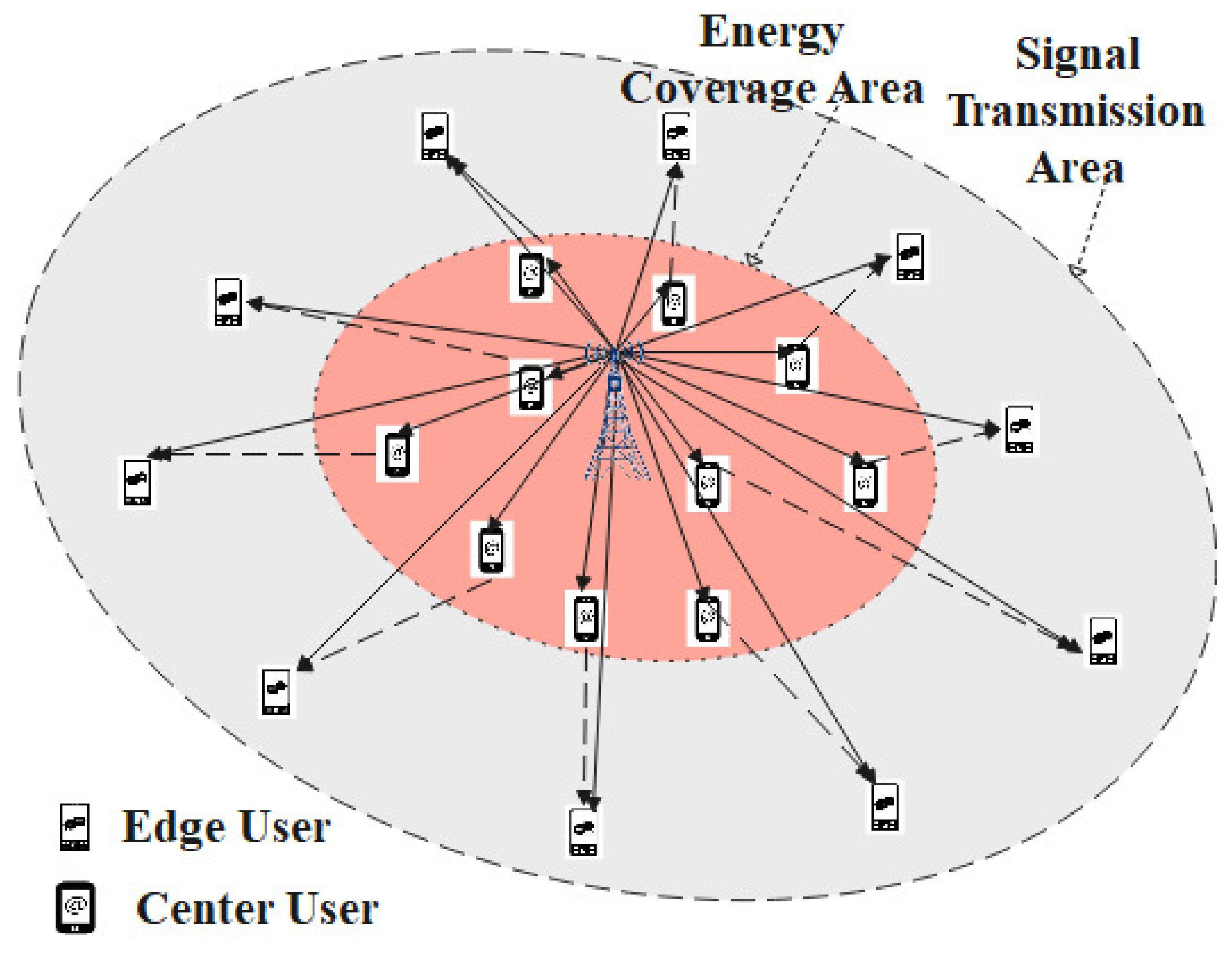
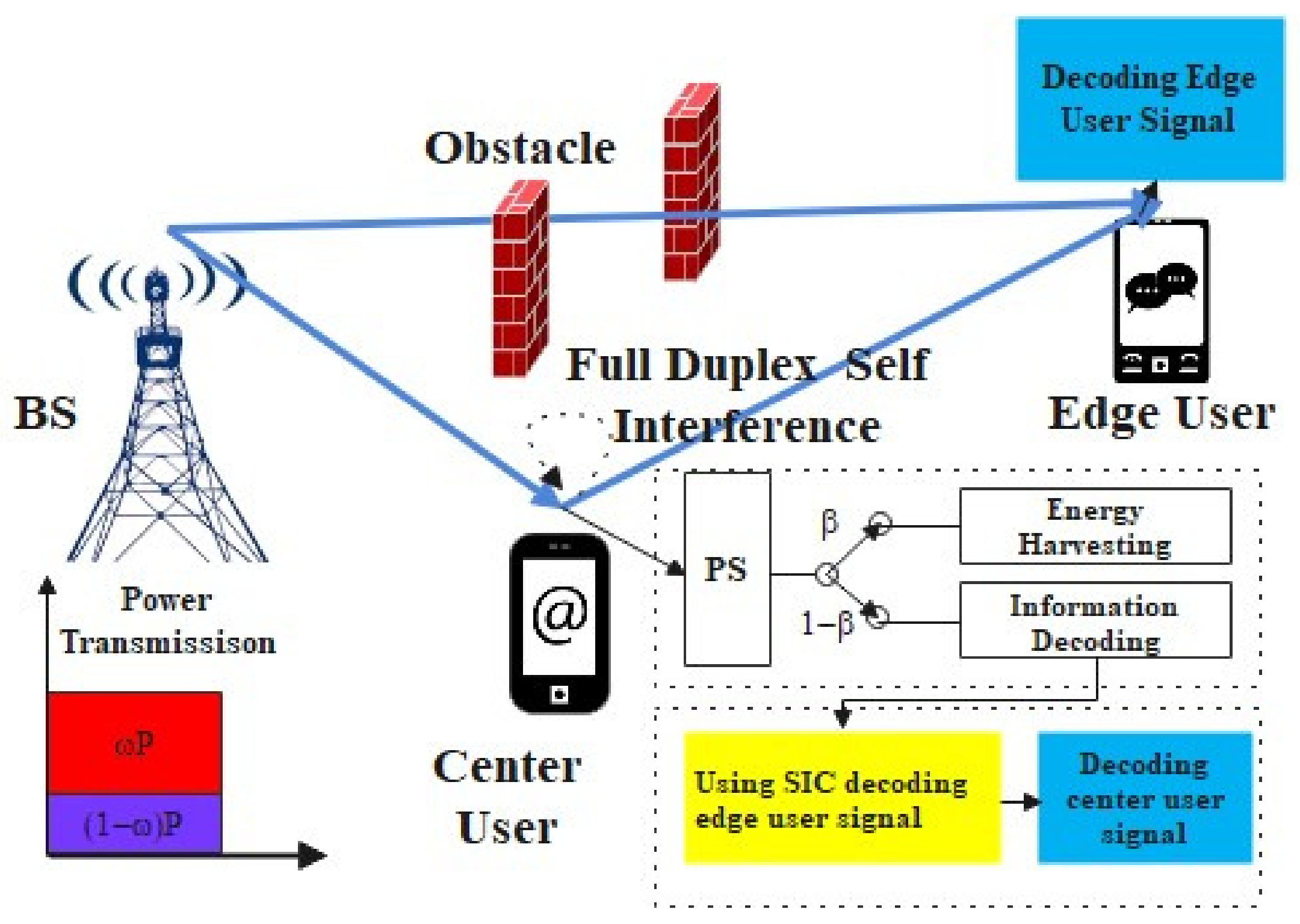
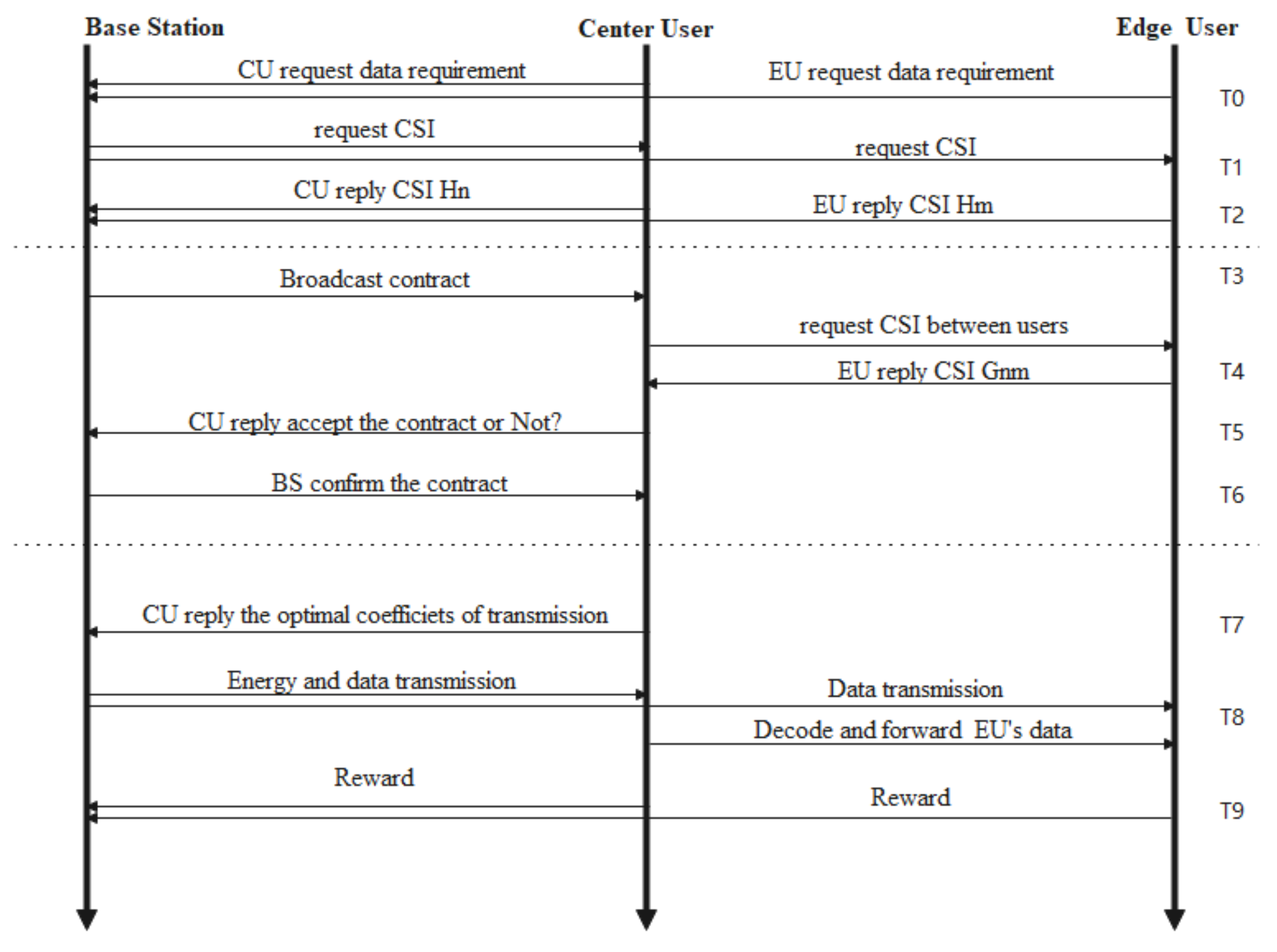
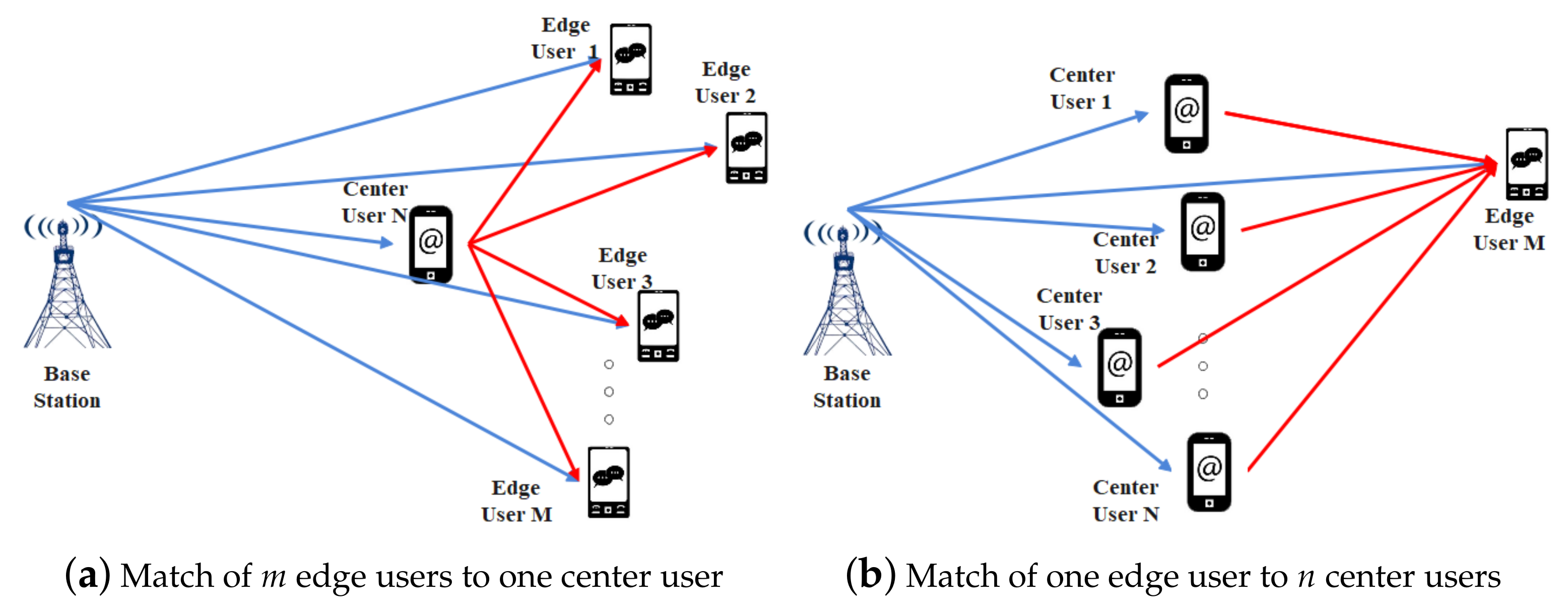

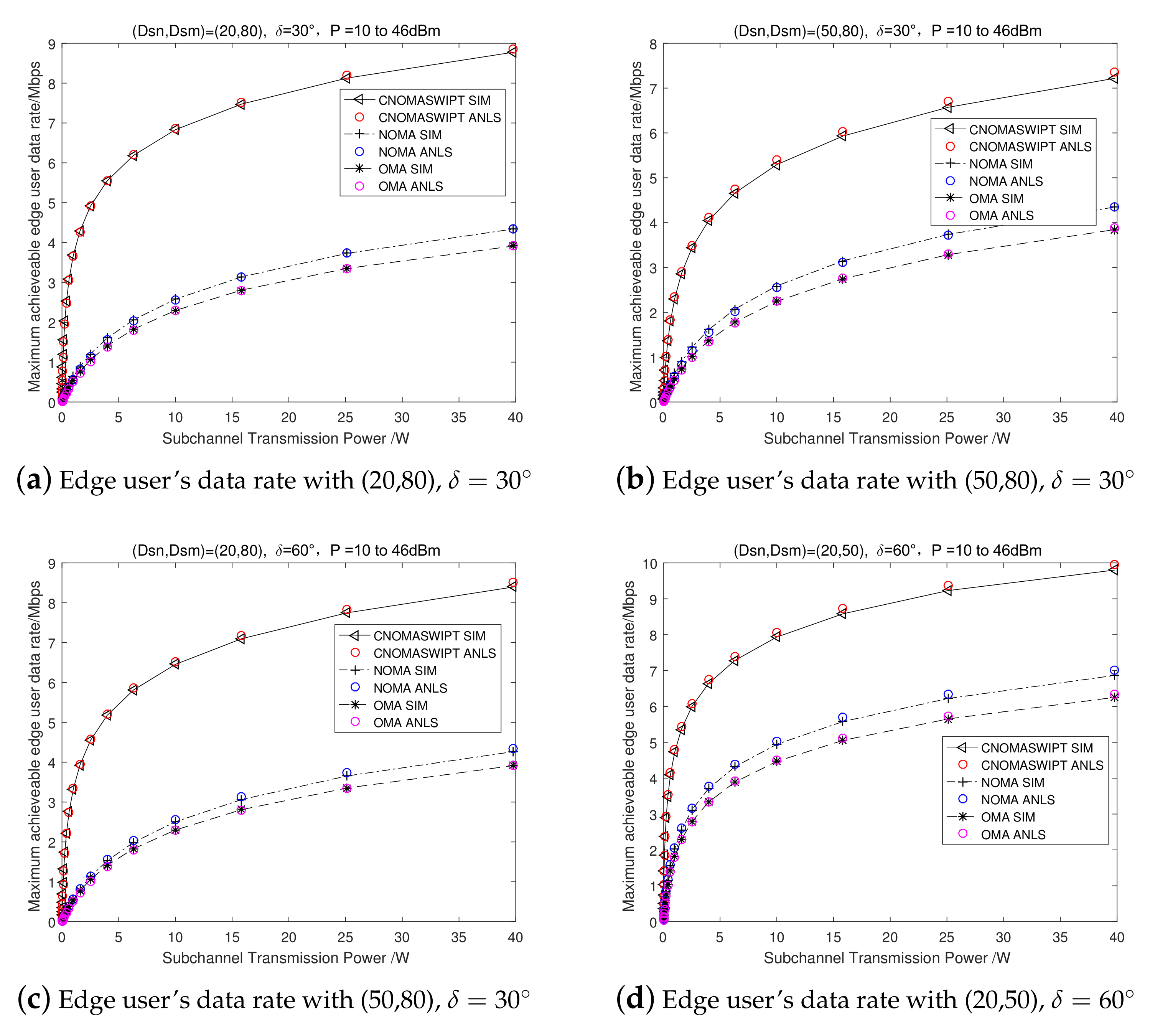
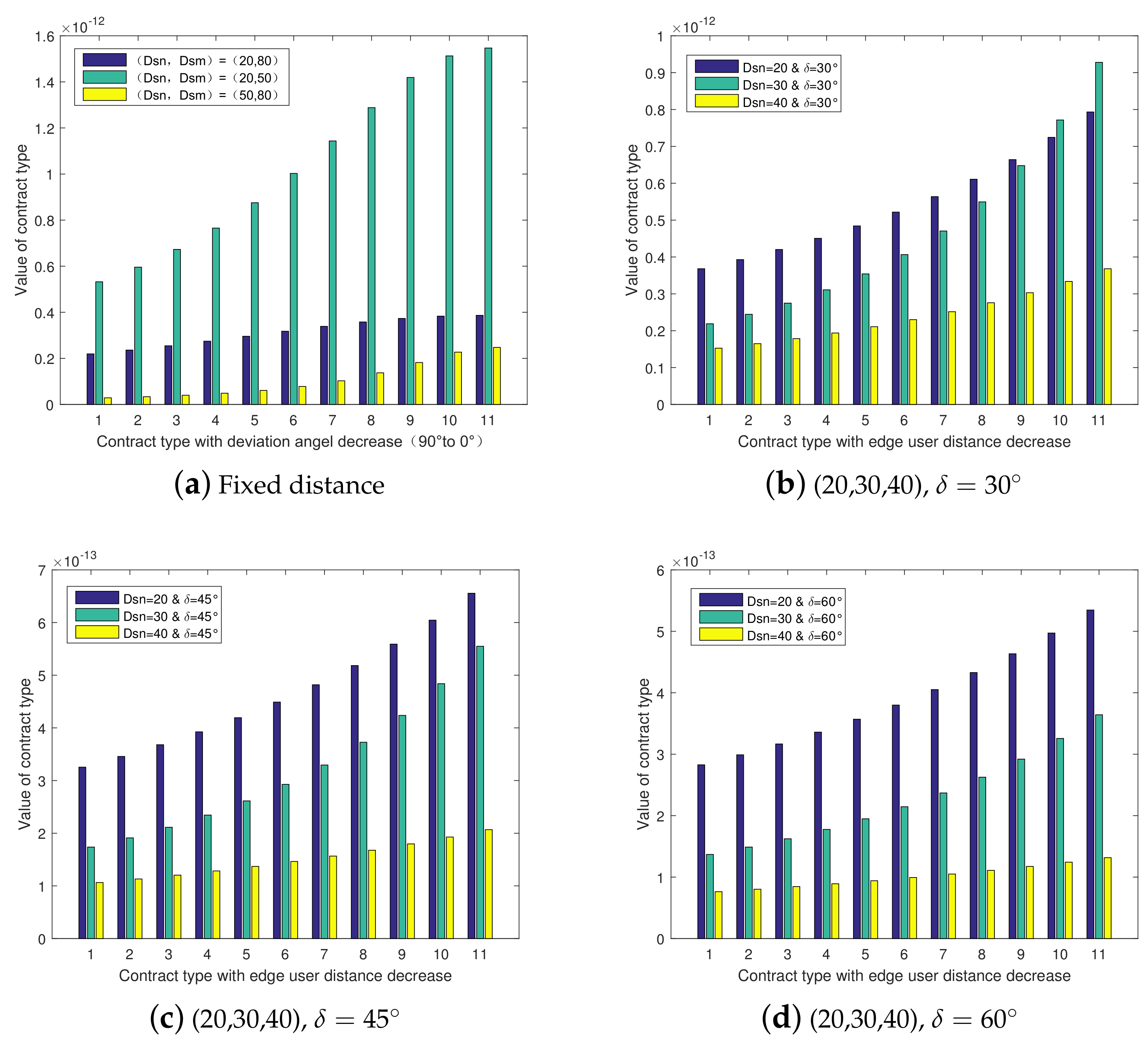
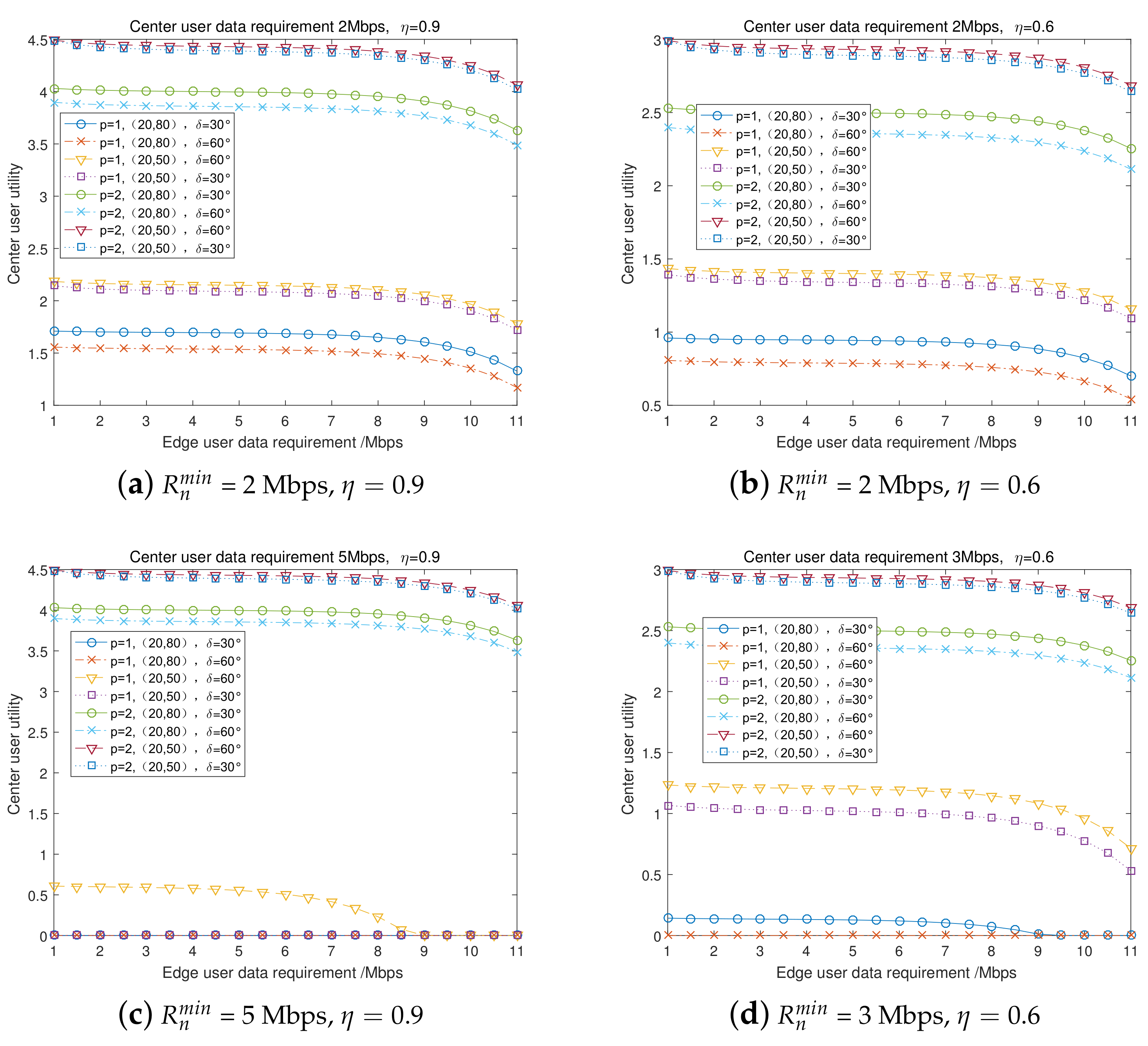
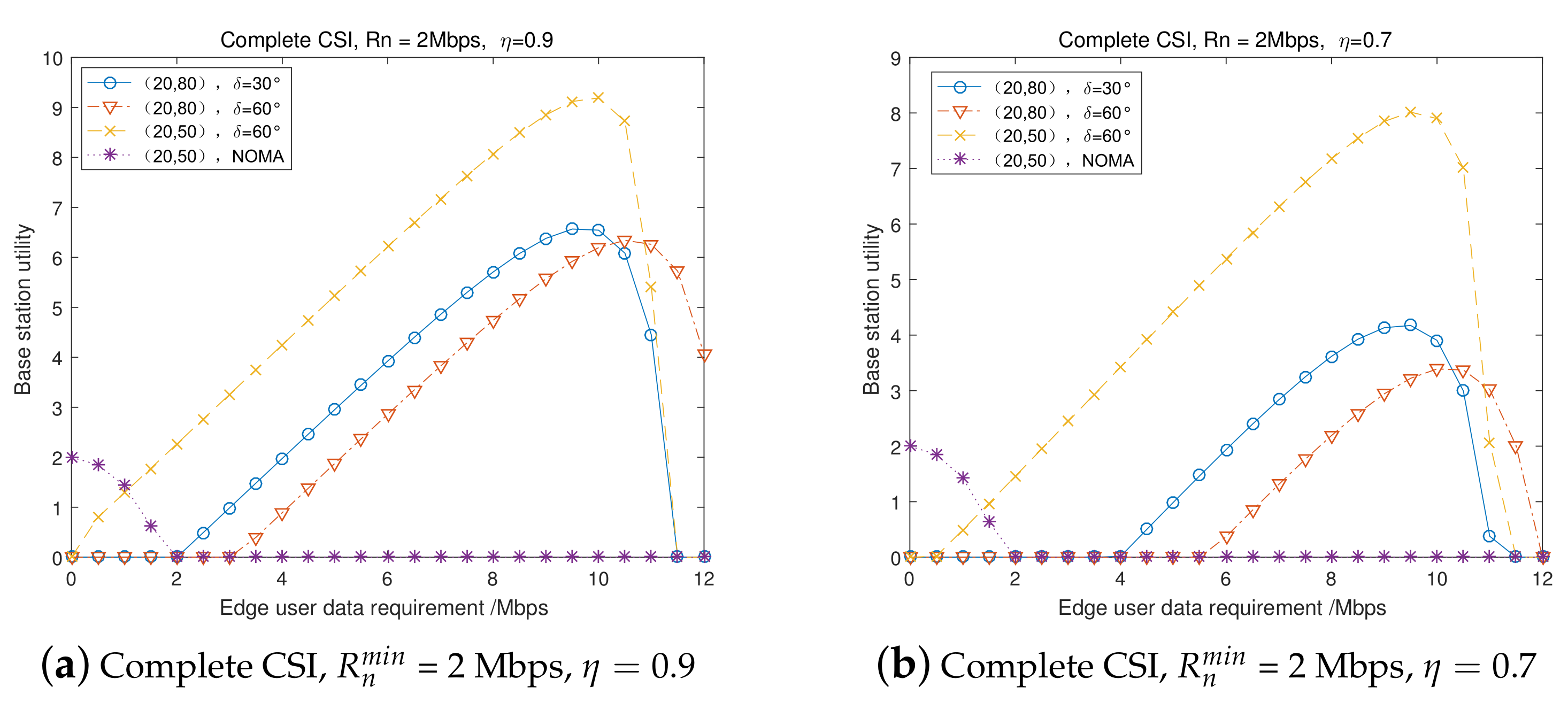

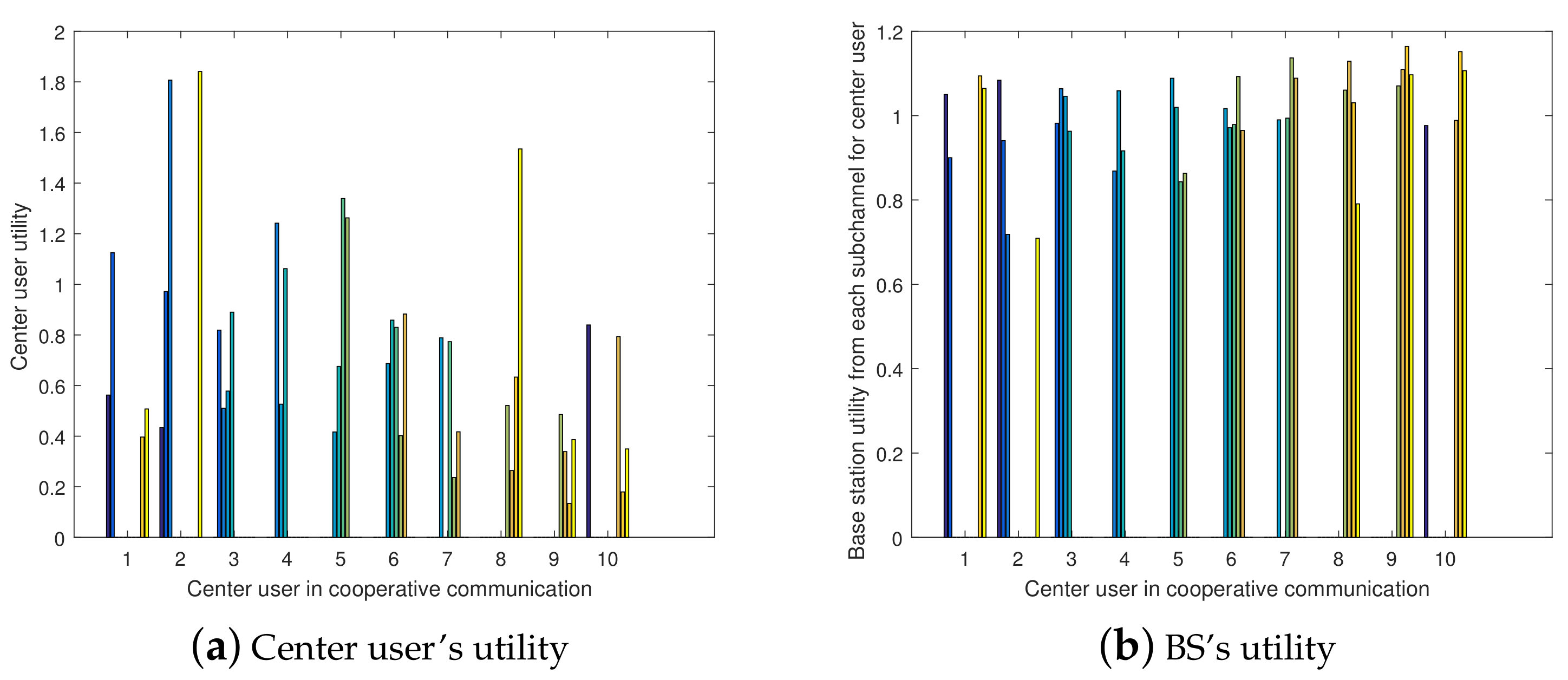
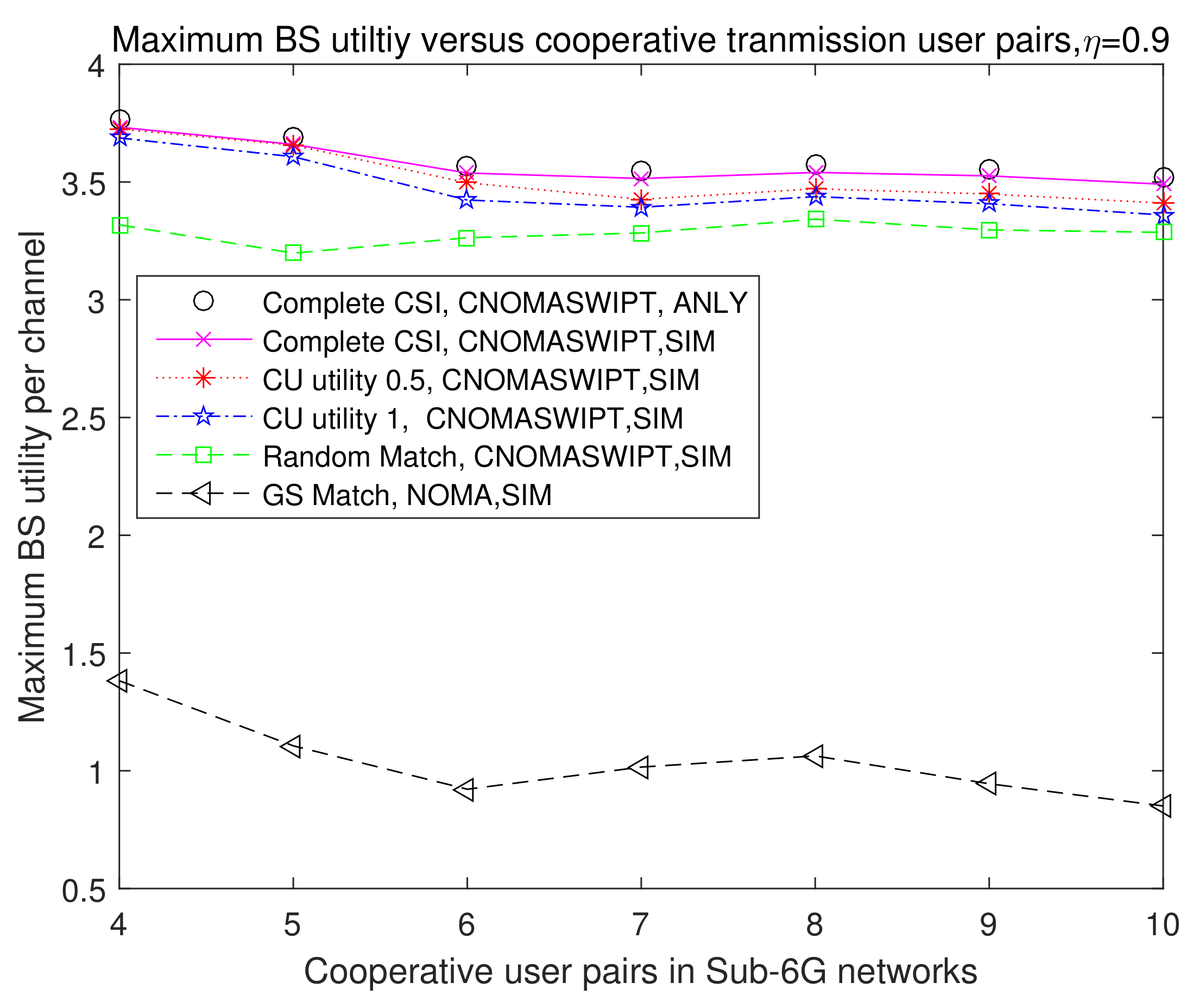
| Parameter | Definition | Value |
|---|---|---|
| Sub-6G network channel bandwidth | 10 MHz | |
| Distance between edge user and center user | 50∼ 120 m | |
| Distance between edge user and BS | 50∼100 m | |
| Distance between center user and BS | 20∼50 m | |
| Base station transmission power | 1∼46 dBm | |
| Electricity circuit power consumption | 10 dBm | |
| Subchannel transmission power | 1∼30 dBm | |
| Power allocation coefficient to edge user | 0∼1 | |
| Path loss factor of edge user | 4 | |
| Path loss factor of center user | 2 | |
| Energy transmission coefficient to center user | 0∼1 | |
| Self-interference cancellation residual coefficient | −80 dB∼0 dB | |
| Energy transfer conversion | 0.5∼1 | |
| Deviation angle from edge user to center user | 0∼90 | |
| Noise power per unit bandwidth | −174 dBm/Hz |
Publisher’s Note: MDPI stays neutral with regard to jurisdictional claims in published maps and institutional affiliations. |
© 2021 by the authors. Licensee MDPI, Basel, Switzerland. This article is an open access article distributed under the terms and conditions of the Creative Commons Attribution (CC BY) license (https://creativecommons.org/licenses/by/4.0/).
Share and Cite
Zhang, Z.; Qu, H.; Zhao, J.; Wang, W. Contract Theory-Based Incentive Mechanism for Full Duplex Cooperative NOMA with SWIPT Communication Networks. Entropy 2021, 23, 1161. https://doi.org/10.3390/e23091161
Zhang Z, Qu H, Zhao J, Wang W. Contract Theory-Based Incentive Mechanism for Full Duplex Cooperative NOMA with SWIPT Communication Networks. Entropy. 2021; 23(9):1161. https://doi.org/10.3390/e23091161
Chicago/Turabian StyleZhang, Zhenwei, Hua Qu, Jihong Zhao, and Wei Wang. 2021. "Contract Theory-Based Incentive Mechanism for Full Duplex Cooperative NOMA with SWIPT Communication Networks" Entropy 23, no. 9: 1161. https://doi.org/10.3390/e23091161
APA StyleZhang, Z., Qu, H., Zhao, J., & Wang, W. (2021). Contract Theory-Based Incentive Mechanism for Full Duplex Cooperative NOMA with SWIPT Communication Networks. Entropy, 23(9), 1161. https://doi.org/10.3390/e23091161






